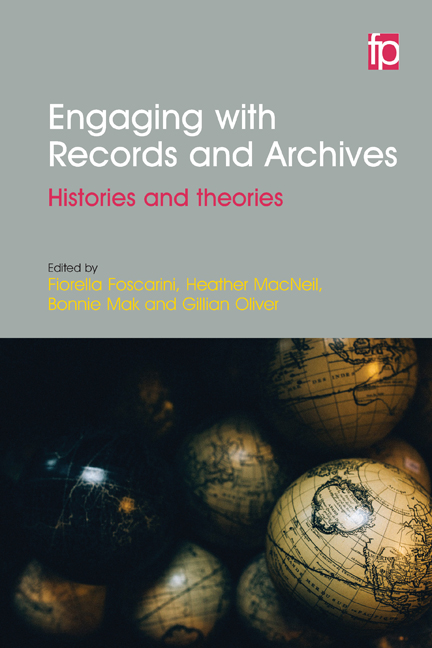Book contents
- Frontmatter
- Frontmatter
- Editors and contributors
- Editors’ introduction
- PART 1 RETHINKING HISTORIES AND THEORIES
- 1 Moving the margins to the middle: reconciling ‘the archive’ with the archives
- 2 Organisms, skeletons and the archivist as palaeontologist: metaphors of archival order and reconstruction in context
- 3 ‘Records in context’ in context: a brief history of data modelling for archival description
- 4 Mapping archival silence: technology and the historical record
- 5 Hidden voices in the archives: pioneering women archivists in early 20th-century England
- PART 2 ENGAGING RECORDS AND ARCHIVES
- Index
2 - Organisms, skeletons and the archivist as palaeontologist: metaphors of archival order and reconstruction in context
from PART 1 - RETHINKING HISTORIES AND THEORIES
Published online by Cambridge University Press: 08 June 2018
- Frontmatter
- Frontmatter
- Editors and contributors
- Editors’ introduction
- PART 1 RETHINKING HISTORIES AND THEORIES
- 1 Moving the margins to the middle: reconciling ‘the archive’ with the archives
- 2 Organisms, skeletons and the archivist as palaeontologist: metaphors of archival order and reconstruction in context
- 3 ‘Records in context’ in context: a brief history of data modelling for archival description
- 4 Mapping archival silence: technology and the historical record
- 5 Hidden voices in the archives: pioneering women archivists in early 20th-century England
- PART 2 ENGAGING RECORDS AND ARCHIVES
- Index
Summary
AS ARCHIVISTS, WE know that context is important; that it is, in fact, everything. As scholars, we also know that pretty much everything is context; what surrounds the text is virtually infinite. In the case of the Dutch Manual for the Arrangement and Description of Archives (Muller, Feith and Fruin, 1920/1940) we know about the immediate Dutch archival context of its composition, that it was grounded in the practices of its authors and their predecessors, and on their discussions with their colleagues at the Netherlands Association of Archivists (Horsman, Ketelaar and Thomassen, 2003; Ketelaar, 1996; Ketelaar, 1997). We also know that the Manual achieved renown not because of the novelty of its ideas, but as a consequence of the thoroughness of its compilation. As Samuel Muller acknowledged, the combination of concepts and principles that it canonized was already ‘in the air’ when the authors set out to write it (Horsman, 2002).
In articulating those concepts and principles, the Dutch trio used a series of metaphors that has left an indelible imprint on the development of archival science. A common metaphorical thread was woven into the fabric of the discipline, linking archival science to natural history. An archives became an organism possessing a skeleton, record making and keeping were described as a process of accumulation and deposit of sedimentary residues, and the archivist's work was compared to that of the palaeontologist. How did that family of metaphors come to impregnate the theoretical language of archival science in its modern foundational period? Were they as much ‘in the air’ as the concepts and principles that Muller had in mind?
One can dismiss metaphors as merely ornamental or illustrative resources. Scholars who have examined the use of metaphorical concepts in the scientific sphere agree that some metaphors merely add colour or play a pedagogical role. Yet many others so completely frame our thinking, individually and collectively, that we should think of cognition as being metaphorical. In every field of enquiry, metaphors provide ‘the cognitive means to chart the unknown’ (Klammer and Leonard, 1994, 31).
- Type
- Chapter
- Information
- Engaging with Records and ArchivesHistories and Theories, pp. 21 - 40Publisher: FacetPrint publication year: 2016
- 1
- Cited by



